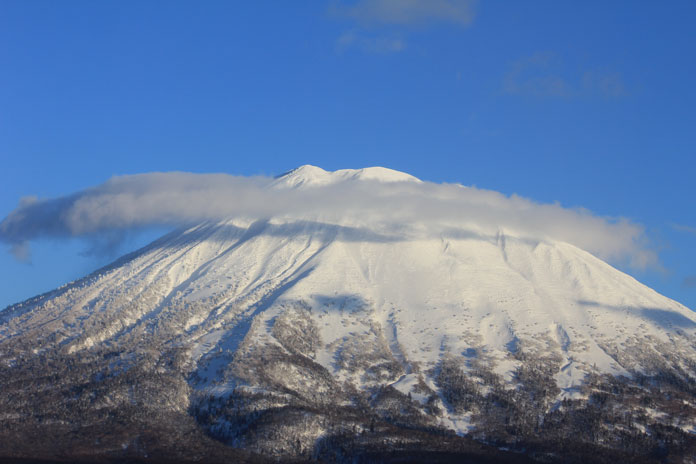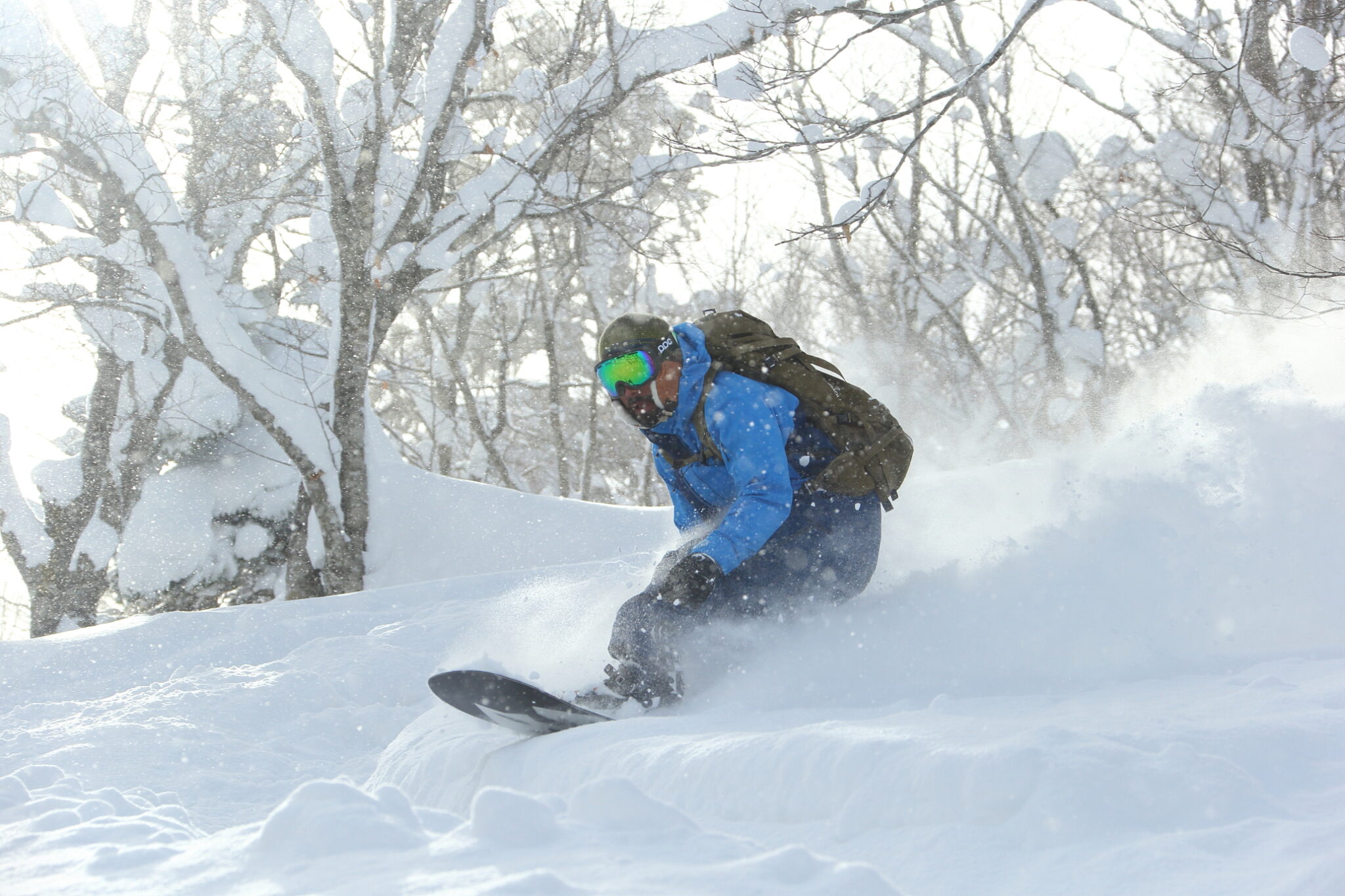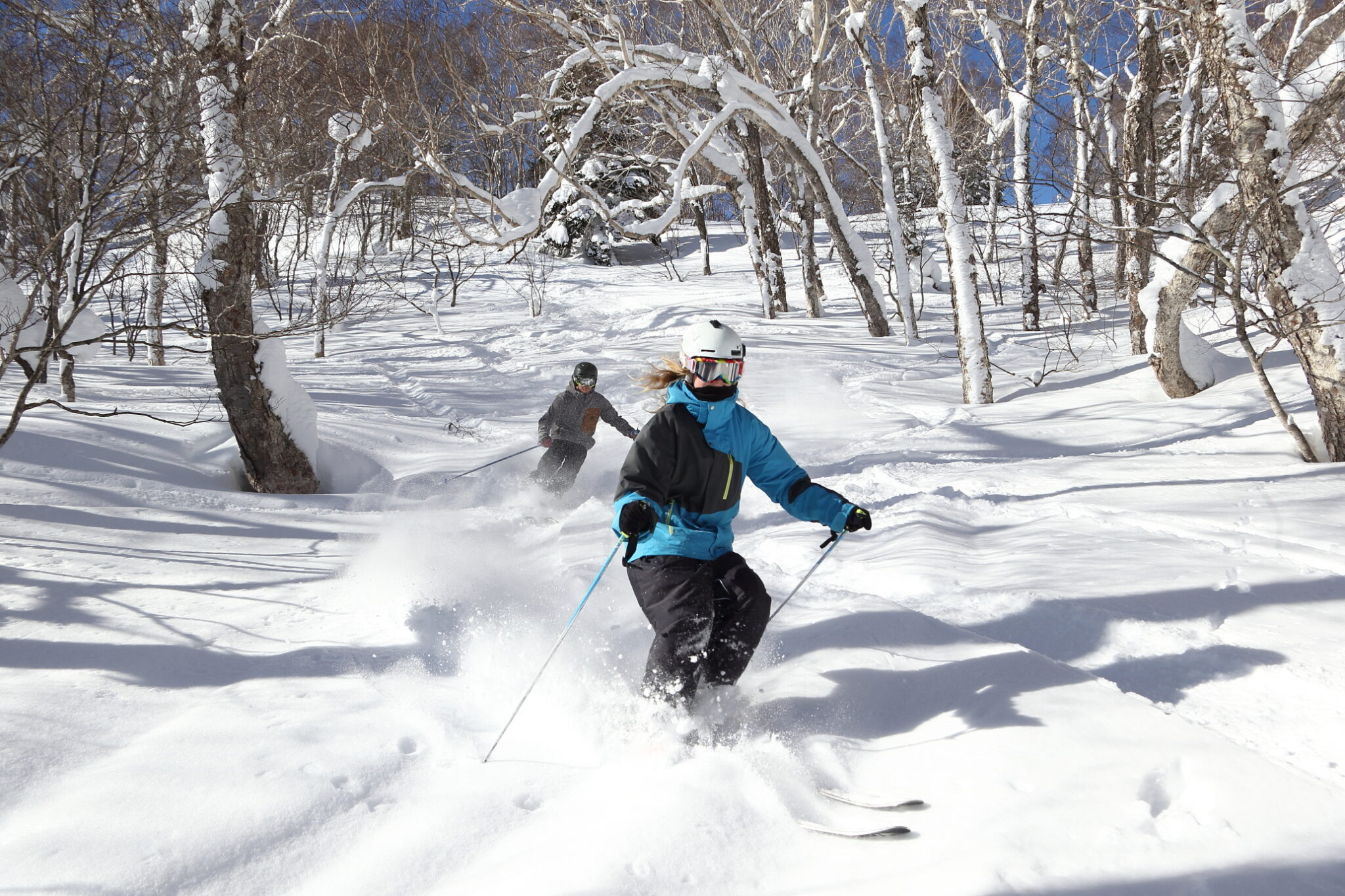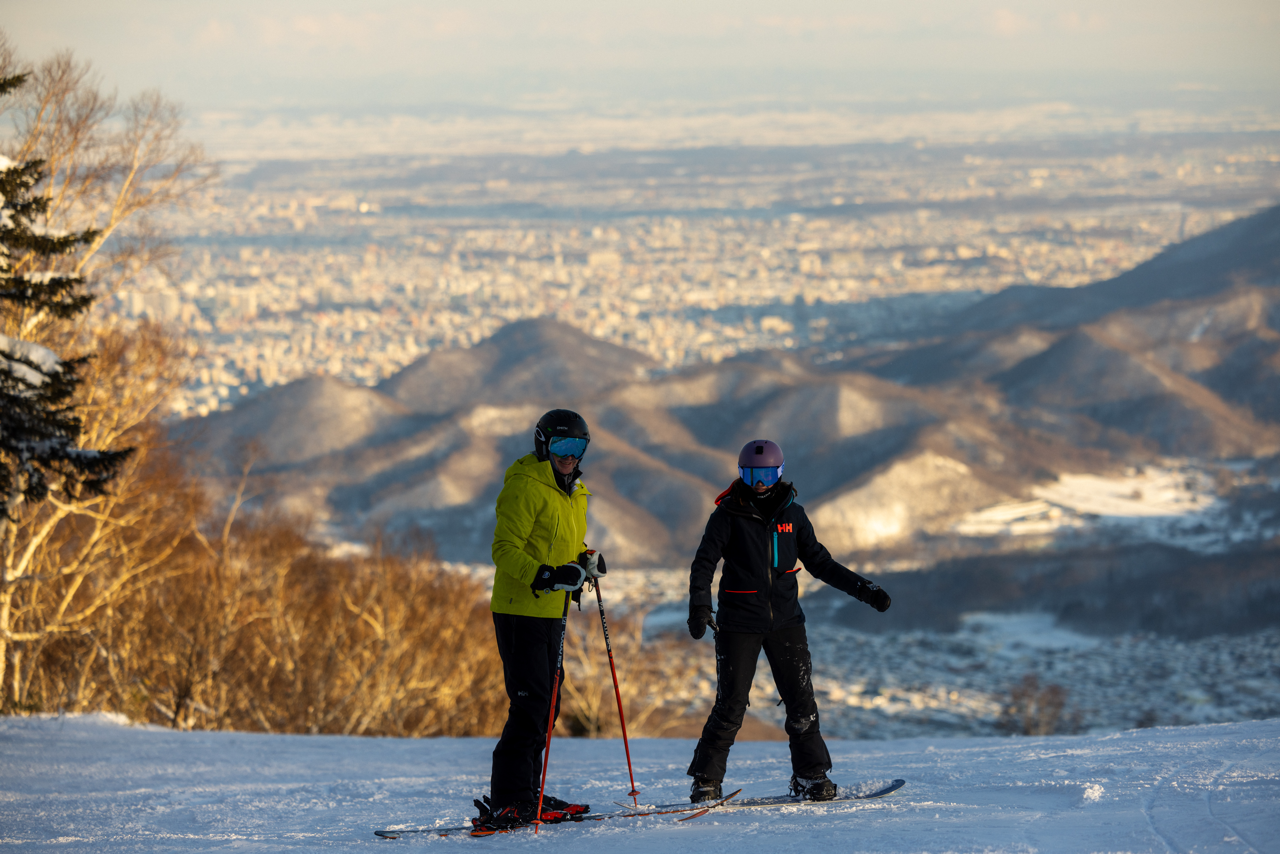JR East Pass ski trips top tips and itineraries
JR East Pass ski trips are the simplest and fastest way to enjoy a wide selection of great Japanese ski areas. Depending on the pass you get 5 or 6 full travel days in 14 days from the date you first use it. Using a JR East Pass it’s amazingly easy to access everything from big resorts to still almost unknown powder paradises and back country cat ski operations.
How fast is a shinkansen? Blink and you’ll miss it .. Seriously, watching the Hyabusa whizz past at one of the smaller stations is fun. If you are downstairs you hear the roar and on the platform gotta be quick to video it!
Fly in to Tokyo and you can be skiing powder – yes, actually on the snow – in as little as 3 hours after landing! The mighty shinkansen (bullet train) makes rail the quickest way from the airport to most of the best ski resorts.
All the rail passes here include both the monorail for Haneda and NEX express line to Narita Airport. The JR East South Hokkaido Pass includes Sapporo’s New Chitose Airport as well.
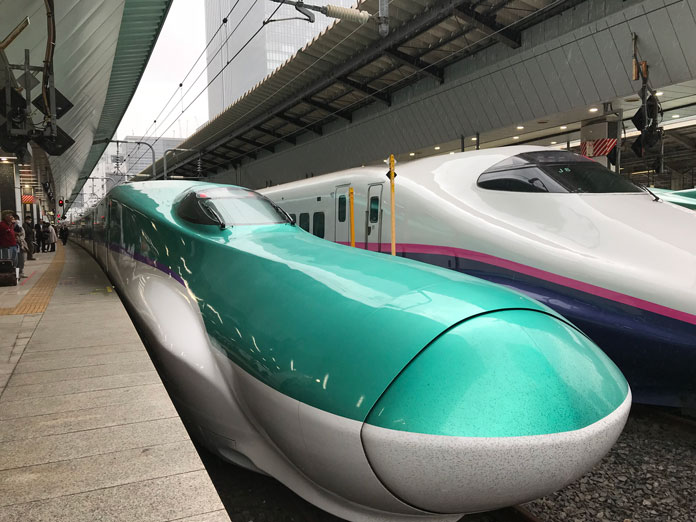
JR East Pass regional options and costs
- JR East Pass Tohoku Area, 5 travel days in 14 days = pre purchase ¥19,350 or ¥20,360 purchased in Japan after arrival; ¥9,670 / ¥10,180 child 6-11
- JR East – South Hokkaido Pass, 6 travel days in 14 days = ¥27,930 or ¥13,960 child purchased in Japan; discount @3% pre purchased
- NEW JR Tohoku – South Hokkaido Rail Pass, Just launched on January 5th this offers 5 travel days in 14 days = ¥19,750 or ¥9,870 child purchased outside Japan
- JR East Nagano – Niigata Area, 5 travel days in 14 days = pre purchase ¥17,310 or ¥18,330 purchased in Japan after arrival; child Y8,650 / Y9,160
The different JR East Passes all allow a lot of variety and big savings copmpared to buying individual rail tickets. In fact, even if you visit just one main resort a JR East Pass is usually a fair bit cheaper than return tickets from either Tokyo airport to the resort.
But they don’t work to combine resorts from Nagano with either northern Tohoku areas or Hokkaido. So if you plan to ski Hokkaido and one or more Nagano areas (Shiga Kogen, Nozawa, Myoko, Hakuba, Madarao) flights will usually work better.
It’s a very good idea to work out your JR East Pass ski trip itinerary first. Which we are here to help you with! After 15 years using JR Rail Passes to unlock numerous ski options we have learnt a few things and discovered lots of great ski areas along the way. Although packing light seems to be eluding us still ..
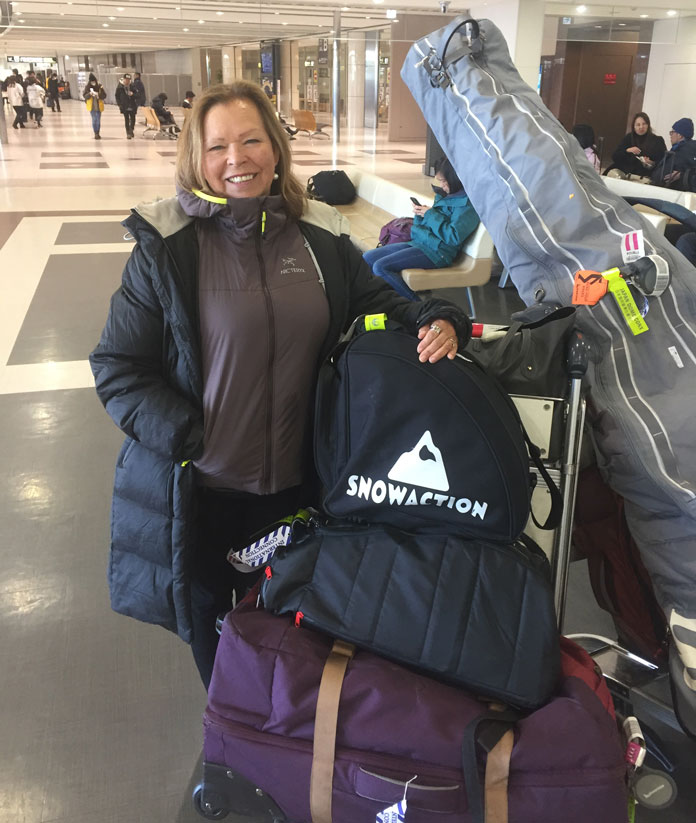
10 Useful Tips for skiing with a JR East Pass
- Maximise your ski time! With 14 days available for using the pass there is no reason not to ski EVERY day if you plan a little – even way up at Hakkoda in Aomori you can ski the afternoon for example catching the 08:20am Hyabusa from Tokyo arriving 11:21am at Shin-Aomori (more on that in Deep North itinerary below)
- Be aware of different shinkansen services – the fastest ones don’t make many stops, so to get to smaller stations you need to check the timetables carefully, it can be quicker to pass your destination station and double back (eg to Kitakami go to Morioka and come back rather than the milk run .
- Use free or cheap direct resort buses from the JR Stations whenever possible – for example, staying at Prince Resorts like Naeba and Shizukuishi guests get free buses available at set times; or for Geto Kogen there are daily buses from Kitakami station etc (more details in our itineraries below)
- Be aware you have to pick up your pass from the list of JR offices – some flights arrive before these open at the airports so you may have to wait a bit.
- With an itinerary planned carefully you can pre-book FREE all the shinkansen sectors you need for the whole trip at the same time as you pick up your pass. If you make up a list of them you just give this to the helpful JR staff (see our itinerary suggestions for where leaving a day open according to conditions overrides this).
- When you pre book try and get seats near the back or ideally the back row on the Tohoku shinkansen so you have a spot to stash bags behind your seat – luggage space is limited and lifting ski bags onto overhead racks a struggle for the less strong/young. On long distance few stop trains I often park the ski bag in the doorway from back row seat position and just hop up to make sure its not on the opening door side when it does stop. Some conductors will get cranky at you and tell you to move it but over the years this usually has worked. NB: this is not much use on double deck trains like the Nagano shinkansen, but works well on Tohoku & Akita trains.
- Travel as light as you can! A work in progress in our case, but the ideal maximum is one backpack/carry on and one wheelie bag each.
- Getting on a shinkansen you need to be at the right spot exactly for the right train according to the number of cars it has: 8, 12, 16 whatever – and match that up with your reserved carriage and seat number. These are colour coded on the platform, so it’s pretty simple to work out in tandem with the destination boards that give you the info about number of cars on the train. Direction signs on the walls and platform also help. Or pick an unreserved car spot without a reservation, but it is much simpler to do the reservations first, some services are all reserved seats. You can do these at the stations – at any shinkansen station in fact.
- Overnight flights may make this impossible on arrival, but try and avoid rush hour in Tokyo. It’s not the best time haul heavy ski/snowboard bags around. If you are NOT skiing every day then using Black Cat (Takkyubin) send luggage ahead is great – but we are assuming you do want to maximise on snow time including on arrival day. To send on departure back to the airport you need to do it 2 days ahead, so this works if you are doing some sightseeing after.
- An alternative is renting from some of the great Aussie owned shops like Harros Snowsports in Niseko & Furano who can send your skis ready to your first destination and you just send them back when you leave. Black Cat only costs AUD $25 or so to anywhere in Japan – this worked great for us last trip as we just flew over/did Tokyo with Mrs SnowAction’s 146cm Kastles in the Douche Bag and had my 192cm fat Kastle MBXs waiting on arrival at Oze-Iwakura.
To plan your inter resort moves for the perfect JR East Pass ski trip use their timetables in English on the JR website here – it’s a bit time consuming but well worth the effort to work out exactly what you need to match your dates/flights etc. Look for the services that operate daily, not the holiday/peak additional services marked with an asterisk.
For pass bookings use the link here
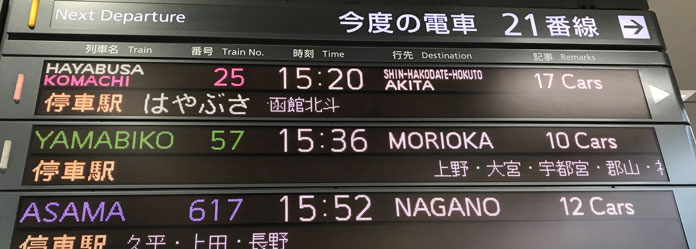
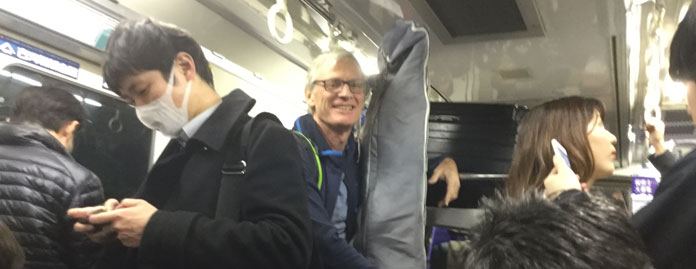
The JR East Pass Tohoku Area ski itineraries
We have a range of itinerary ideas to maximise your JR East Pass options. Here’s one for those who love Japow, hate crowds and like to discover new places.
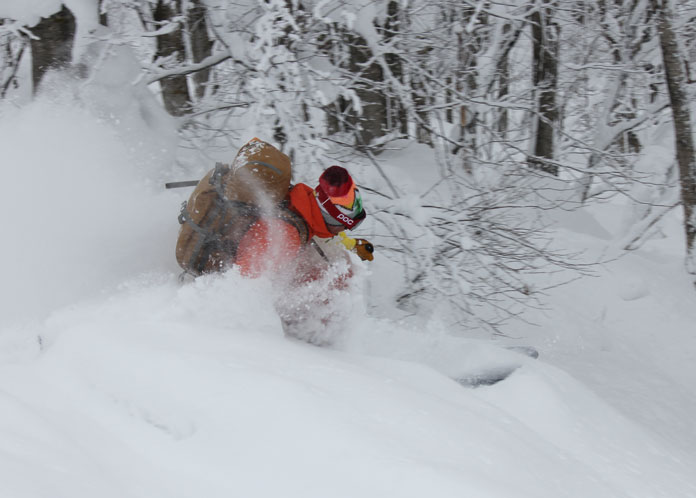
#1 Deep North: Aomori, Akita, Iwate
All the shinkansens are impressive, but our favourite, and the fastest – reaching 328kph – is the Hyabusa / Hyate service. You can get all the way from Tokyo to Hakodate in Hokkaido in just under 4 hours !!! Absolutely amazing, and it makes the seemingly distant ski areas of northern Honshu actually as quick, or quicker, to get to than the Hakuba Valley.
But most Tokyo locals don’t know that. Or they don’t want to pay the extra without a pass, so guess what, it is way less crowded up here than closer to Tokyo areas.
The snow quality is generally similar to Hokkaido – dry, deep and constant from late December to the end of February at least. So let’s get into it!
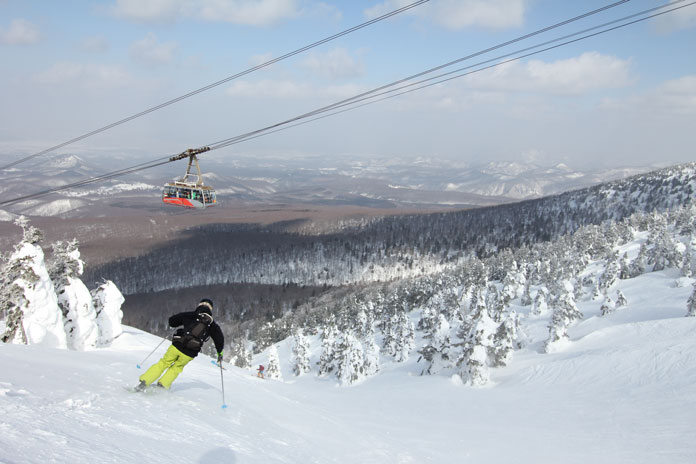
Day 1: JR Pass Travel Day – ski & stay Hakkoda
Arriving in Tokyo at 05:30am grab the Hayabusa 5 08:20am to Shin-Aomori, arriving 11:21am Take a JR Bus or taxi up to Hakkoda.
This powder paradise can be problematic weather wise, the rope way may not be running. If it isn’t by a few single ride tickets on the double chair at the bottom and get your ski legs back. Stay overnight at the base – Sanso for budget travellers, Hakkoda Resort Hotel for mid-range, or for luxury just down the road around the mountain via shuttle bus try Jogakura. They run a free guest shuttle to/from Shin-Aomori at set times and on request for groups of 5 or more.
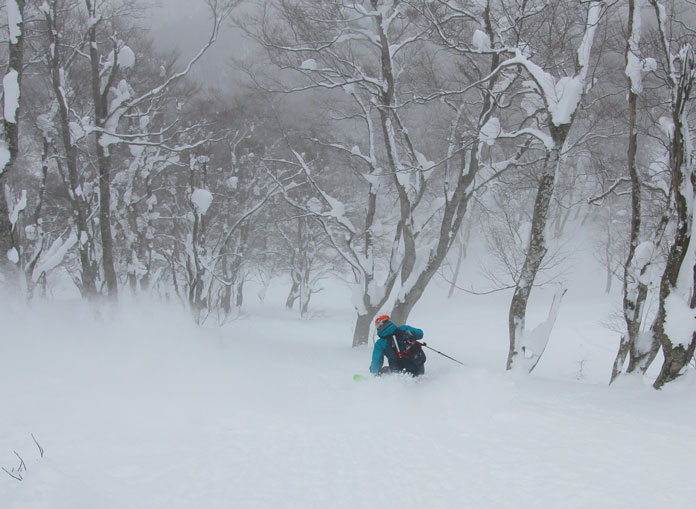
Day 2: Ski & stay Hakkoda
For good days at Hakkoda you seriously want to go with local guides – Chu Hei and his crew at Sanso, or the guys in the little Ski School office building beside the double chair opposite Sanso are excellent, with enough English to get by.
Never go alone here – there are massive tree wells, including along the two main courses from the top which you can ski without a guide if conditions are okay.
In a worst case weather scenario when nothing is going to open get a few fellow Japow fiends together and get a taxi or mini van taxi to Aomori Spring Resort, about 90 minutes drive away. They have terrain that stays open in most weathers including great easy access sidecountry trees). Families with young kids or more cruisy skiers who want some groomers they can switch Aomori Spring for Hakkoda for these couple of days.
After skiing at Hakkoda scoot down the road to one of Japan’s most historic onsens and soak in the 300 year old baths at Sukayu Onsen. It’s old school mixed bathing, but ladies can get the “modesty apron” (more of a popover sack) for Y1,000 in the souvenir shop or just stay behind the screened off area nowadays. You could also stay here – when open it’s possible to ski back to it from the ropeway.
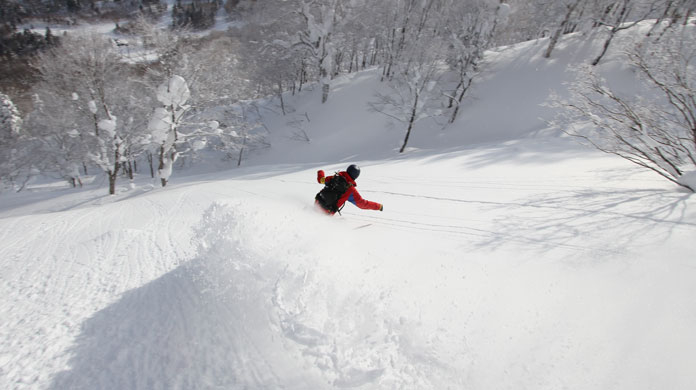
Day 3: JR Pass Travel Day to Appi/Hachimantai – ski Hakkoda or Appi
This is one day you can leave timing open. If conditions are good for the ropeway get on it, ski the morning, and travel to Morioka in the afternoon.
But if conditions are bad – check the wind forecast – and the ropeway is not operating then just go in the morning down to Aomori for the trip down to Morioka.
Either way, from Morioka get the bus to Appi. This major resort has a big range of excellent accommodation from hotel rooms to loft apartments which is mostly ski in/ski out right at the base. Appi has great skiing and riding for all standards.
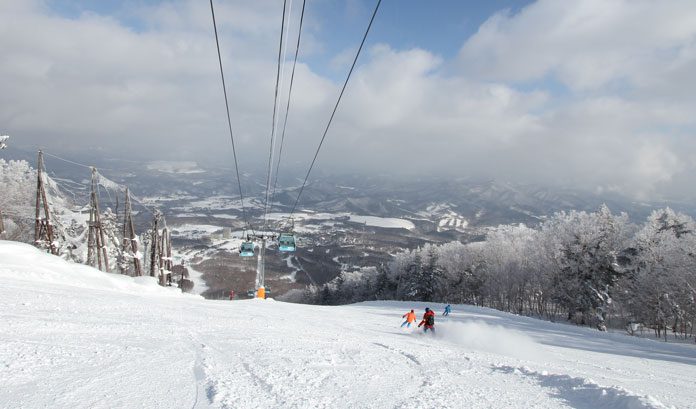
Now owned by a Chinese company, with direct flights into Morioka, it is getting a lot busier around the hotels and base runs. But there is plenty of ski room and an excellent lift network. Also, the Chinese are not yet into the powder much, so you can enjoy Appi’s powder zones still without as much competition as many other places further south.
OR if you are on a budget you can stay in Hachimantai town, with plenty of options. Or for a great value 5 star deluxe option stay at Hachimantai Panorama Resort.
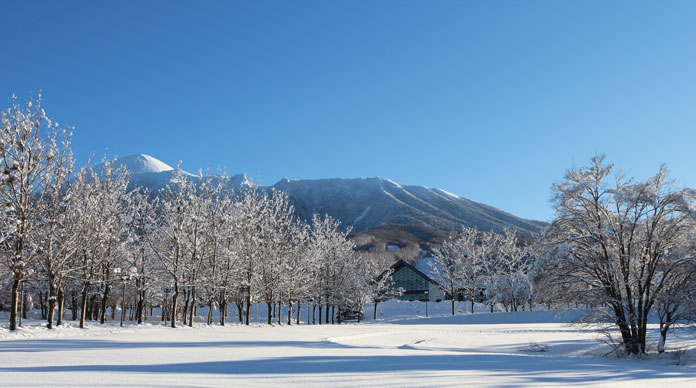
Day 4: Ski & stay Appi / Hachimantai area
Get up and get into Appi! Powder days here are frequent and special. You can stay in Hachimantai City, but if you don’t get down there on the evening bus for a cheap big night out in one of the Izakayas.
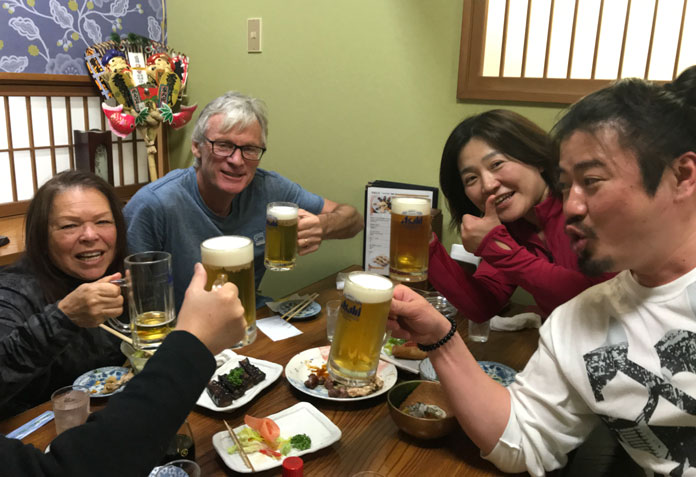
Day 5: Ski & stay Appi / Hachimantai area
Try awesome Hachimantai Shimokura for a complete getaway powder experience using the bus to get over there. Families/cruisier skiers can check Hachimantai Panorama instead.
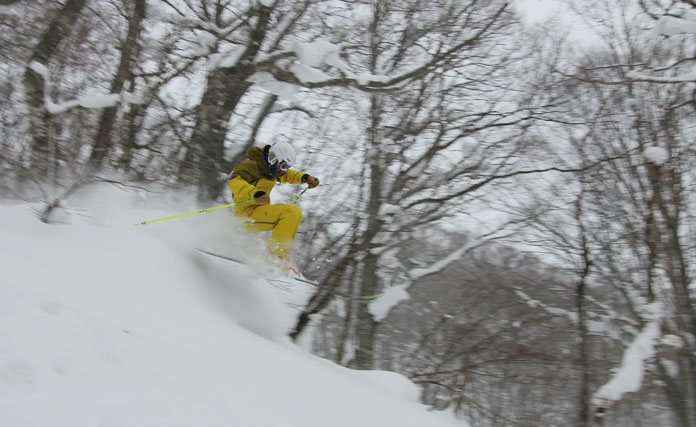
After skiing don’t miss the Matsukawa Onsen school bus experience – riding an old 60s Izusu bus up a wild canyon road in Iwate National Park to a beautiful onsen. Stay Appi or Hachimantai as above.
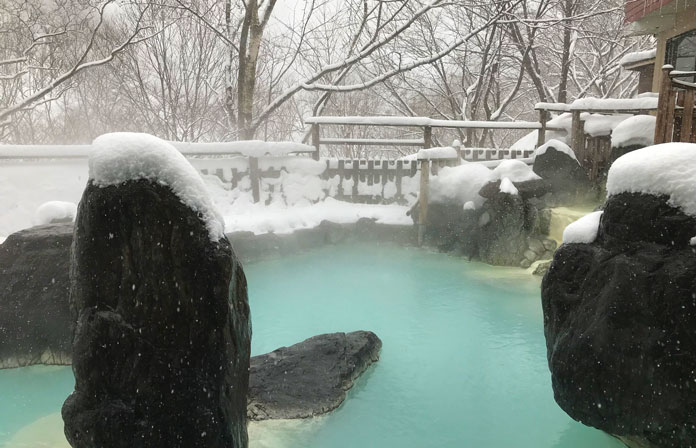
For more powder check out father and son team Boss and Jun Kuragane at Hachimantai Cat Skiing / Cat Tours.
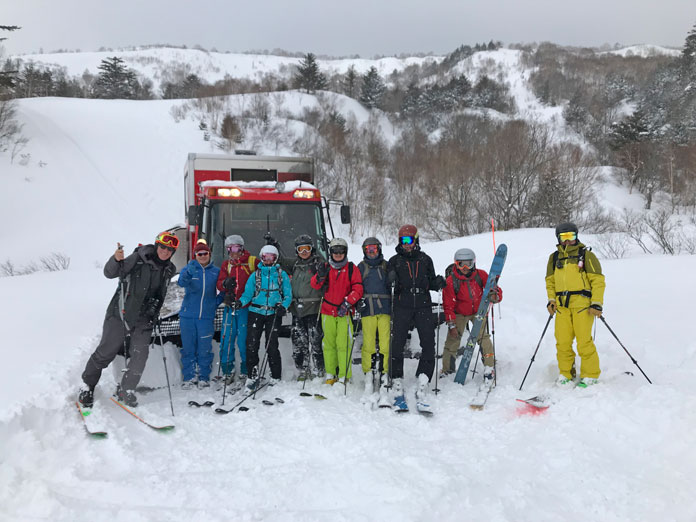
Day 6: Travel day – no Pass needed! – Appi to Shizukuishi
How good is this itinerary? No need to use your JR East Tohoku Pass today, save a travel day! But change resort to another awesome less busy powder gem, Shizukuishi.

Shizukuishi is a Prince Resort with just the one ski in/ski out hotel. As at all Prince ski areas, kids to 12 years ski free so it’s ideal for families.
Book in here for 3 nights – there are usually some great Early Bird deals to do that – and get their FREE bus from Morioka station after getting the bus down from Appi. If you get the 11:10am Prince shuttle you will be skiing by lunchtime, or get the 9:00am shuttle from Morioka and enjoy nearly a full day.

Or if it’s a pow day at Appi go for it early there and head out in the afternoon and get the 17:50pm Shizuikuishi bus (on weekdays – weekends and public holidays last one is 14:55pm)
Day 7: Ski & stay Shizukuishi
For something different get up early and do the Sunrise Cat Tour to the former FIS World Alpine Championships Downhill Course. That may sound scary, but it’s actually a mellow cruise for good skiers, hopefully with fresh snow off the sides, and easy for intermediates too who can just schuss down the track the cat makes going up. Enjoy great sunrise views over Iwate. If it is a pow day you are already up early to get up to the top lifts at Shizukuishi and make the most of it. See our full Shizukuishi feature for more details on the resort and the pow options.
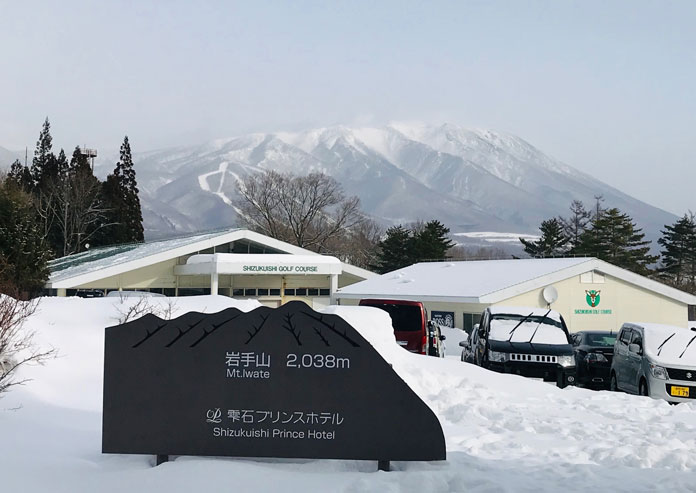
Day 8: Ski Amihari Onsen stay Shizukuishi
Shizu is not huge but for variety they run a shuttle bus to Amihari Onsen across the valley, and Iwate Kogen Snow Park close by. All 3 are skiable on an interchangeable ticket so you can do both of these same day if you want – at 710m & 583m vertical respectively they are both worth a look. Of course there’s an onsen too. The onsen in the hotel at Shizukuishi is excellent, with a big carp pool beside the open to the elements main bath.
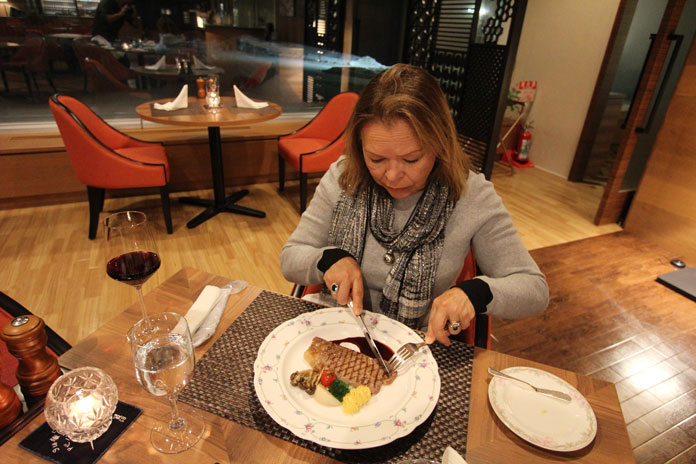
Day 9: JR East Pass Travel Day to Tazawako – ski Tazawako
Head back from Shizukuishi Resort to Morioka and ride the Akita Shinkansen (Komachi) – which is unique as it runs at normal train speeds on the single track line across to Akita and at bullet train speeds from Morioka to Tokyo – to Tazawako. A few services stop at Shizukuishi town, which is closer to the ski area – best to check timetables carefully. It’s not far to Tazawako station, from where gorgeous Tazawako Ski Area is waiting a short taxi ride away.
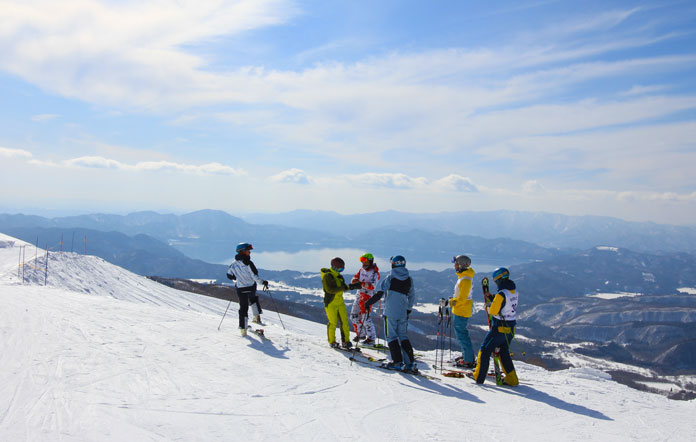
Tazawako is a medium size area with nice open cruising runs boasting great vies over Lake Tazawa. There are some big backcountry options above the lifts on Mt Akita Komagatake – top lift is 1,186m the peak is 1,623m and the treeline around the top lift level.
So it’s alpine, exposed, and subject to plenty of avi danger. For all of the above contracting the local guide experts at Tazawako Back Country Tour Guide (the site is in Japanese with email link for bookings) www.tazawako.net/winter_tour/backcountry.html is recommended.
The snow cat trip up the summer road over to Iwate provides more variety. Like the Shizukuishi sunrise cat, almost anyone can do it – intermediates just follow the cat track road back down enjoying the views.
We hit the sides, finding some nice pow gullies in the trees. But be very careful not to stray too far from the path or you will have a long wade/hike back out – unless you have a local guide who can ski you back to the hotels which are 3km below the ski resort.
You can stay ski in /ski out very cheaply at the Sports Hostel complex. It’s not flash, but it’s impeccably clean and includes simple meals. We met a bunch of local students staying there.
Book it at www.tazawako-sports.com
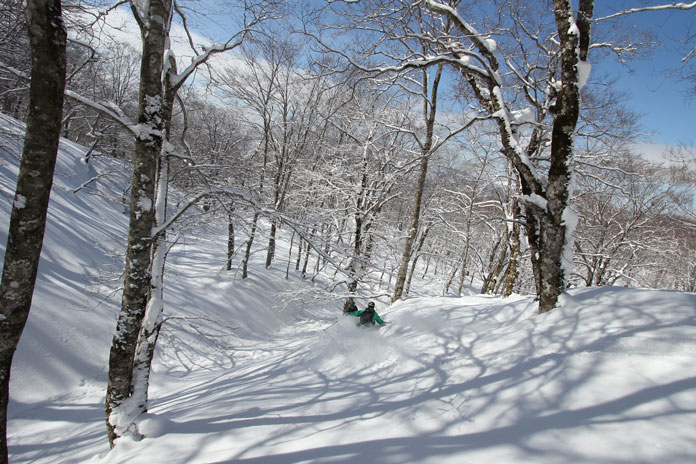
Day 10: Ski / cat ski & stay Tazawako
Between the cat and the side country Tazawako is worth an afternoon and full day at least.
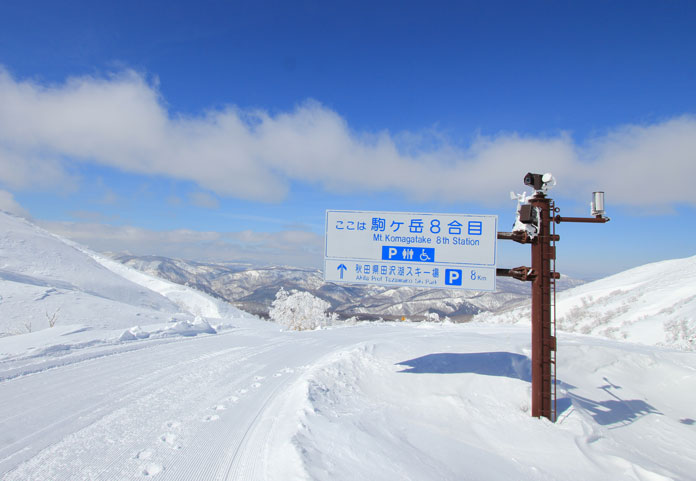
Day 11: JR East Pass Travel Day to Geto – ski & stay Geto/kitakami
Have an early breakfast and make sure you get down to Tazawako station well in time to catch Komachi 10 at 08:12am to Morioka at 08:50am Change to the Hyabusa 108 at 09:07 for the short 20 minute ride south to Kitakami, the access point for Geto Kogen, “King of Powder” as they modestly, but quite truthfully, describe themselves.
Depending on your accommodation choice – you can stay in well priced mid range hotels at Kitakami Station, in which case just cross the road and drop the bags then depending on the day there may be still a free Geto bus to catch, or worst case get a taxi. There are buses daily up at 07.40am, 09.10am & 15.40pm weekdays, plus a 10.40am service weekends.
Or if you are staying at one of the Onsen options en route you can bus it all the way with everything and store the bags at Geto for the day, or get a taxi and drop them off on the way up – it’s about 45 minutes from the station. The last section of the road can get very snowy.
If you are staying at Geto’s funky Camp 88 backpacker in the base complex you can just drop the bags there and go skiing.
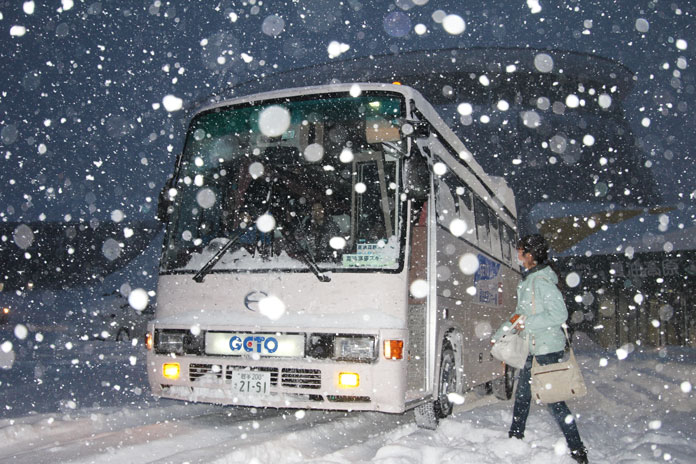
Day 12: Ski & stay Geto/Kitakami
Pow days are special at Geto, they get a lot of them but it is more on the radar now – especially with organised tour groups. If you are in one of those groups a dozen or more skiers & boarders will trash anything in not time. You don’t need a guide at Geto, the courses are well marked, just going with a buddy or two you can repeat areas for a few laps. Being there early when it fires up early is great. The ‘nighta’ can be awesome indeed – it made our list of Top 5 night ski spots in Japan.
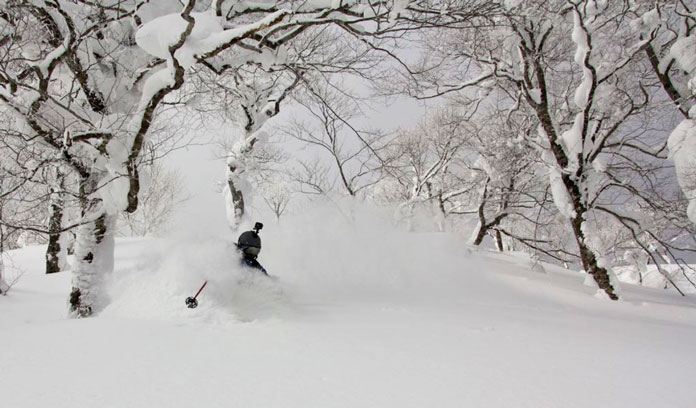
The indoor/outdoor onsen next to the Camp 88 backpacker is great on site here, or staying down the road at either Semi Onsen, which has some deluxe private onsen rooms, or Irihata Onsen whcih is the closest accommodation otherwise and an excellent option for people not wishing to share in backpacker style. This great value Japanese style Ryokan is just 10 minutes drive down the road from Geto, beside a river below a big dam wall. Enjoy comfortable tatami rooms, spotless share facilities and onsen, and delicious Japanese style breakfasts and dinners – the friendly chef didn’t even mind me heating up my cold poached egg. They run a free shuttle service to resort at set times as below.
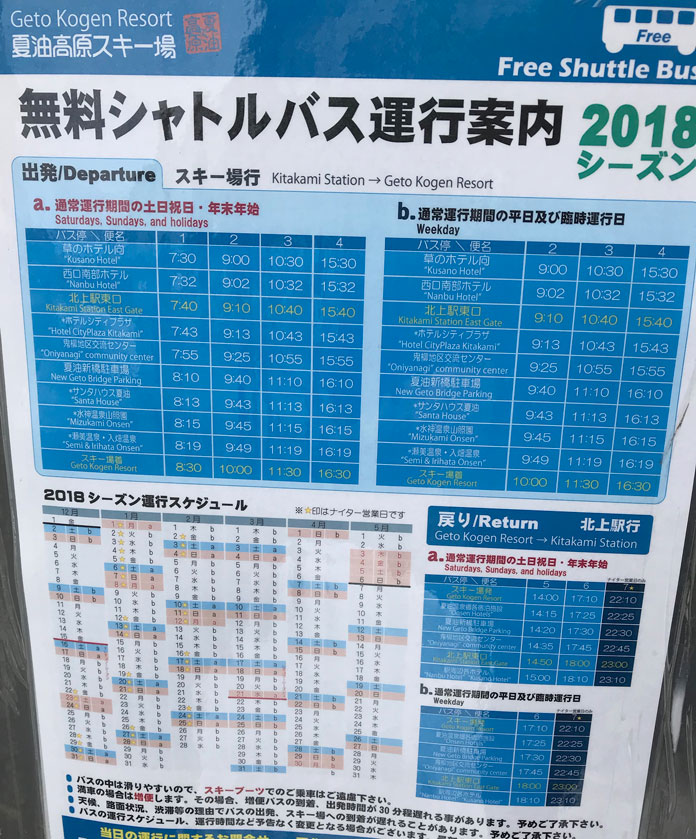
Check Kitakami deals here – it’s a big country town with some izakayas and excellent value hotels.
Booking.comDay 13: Ski & stay Geto/Kitakami
Eat, soak, sleep, repeat ..
Day 14: JR East Pass Travel Day to Tokyo airport – ski Geto
An evening or late evening departure from Haneda or Narita will leave you time to ski the morning – like Yamabiko 51 from Kitakami at 15:07pm, arriving Tokyo 18:24pm or Yamabiko 50 at 14:29pm arriving 17:24pm to Tokyo. You will need to get a taxi down for these.
Following Snow Action’s JR East Tohoku Pass ‘Deep North’ itinerary suggestion you will have skied 14 days straight, at up to different ski areas, plus had the chance to enjoy 3 different cat ski experiences, and stayed at 5 locations (3 for 3 nights and 2 for 2 nights), had some amazing onsen, some great local food. All this and apart from the JR East Tohoku Rail Pass you will have only paid for a handful of buses or taxis in addition.
An extra bonus, no day here involves excessive travel times.
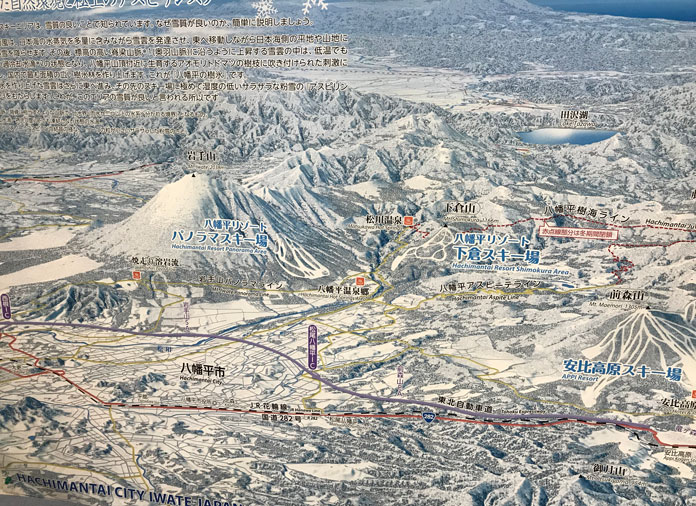
Deep North Tohoku ski itinerary Variations
For powder fiends the itinerary as is will work just fine. Where noted you can leave your travel options open – a powder morning on the doorstep beats what you might find elsewhere later, so be flexible.
For families or cruisier skiers choose Aomori Spring instead of Hakkoda at the start for the first two nights, and adding a third night at Shizukuishi, where kids to 12 years ski free, and have one less night at Geto. With little kids staying at Hachimantai Panorama Resort for the Appi nights is also a good idea for a much quieter experience.
A detour to Aizu is very feasible as well – for example, to Nakonosawa Onsen with the chance to ski a variety of nearby areas. This is close enough to get an Express bus back to Haneda on your final day too if you use up all 5 JR Pass days, or trim a couple of days to fit it all in.
For those doing Hokkaido as well with the JR East Tohoku-South Hokkaido Pass you could have whatever time wherever you want up in Hokkaido first, then use the pass on day one to get down from Sapporo or Kutchan/Niseko or Otaru (from Kiroro for example) to Aomori. Since it gives you a 6th travel day in 14 you could trim a couple of days at Geto and 1 at Shizukuishi or Appi 3 days somewhere in Hokkaido into it.

Or the cheaper new JR Tohoku – South Hokkaido Pass with 5 days in 14 will work quite well allowing for slower traveling times getting anywhere to and from Shin-Hakodate in south Hokkaido – such as to Niseko (tip get off at Hirafu station not Niseko!). You will not be able to ski a morning and get back up to New Chitose from Tohoku unless for a late flight – which after 6 hourse on trains is not a great idea. You could ski Niseko in the morning and then head to Aomori arriving at night to Hakkoda. So dropping Tazawako and a night or 2 at Geto frees up 3 or 4 nights for Niseko within the 14 day itinerary pass limit.
But it doubles up on slower trains. To do Tohoku and Hokkaido itineraries it is usually better to combine them with flights into Sapporo and out of Tokyo or vice versa and do Hokkaido before or after the Tohoku stuff. Just get a bus to or from your Hokkaido resort.
Stay tuned for more JR East Pass ski trips itineraries. Let us know your tips too.
